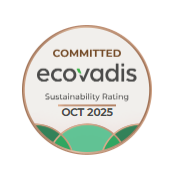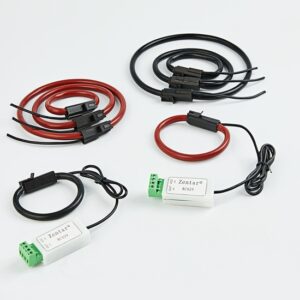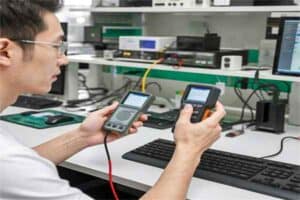Modern power systems face a double challenge: ensuring high efficiency while maintaining power quality. As more industries adopt inverters, rectifiers, and other non-linear devices, harmonic pollution and reactive power losses are on the rise. To tackle these issues, reactors (inductors) and capacitor compensation cabinets work together to stabilize voltage, suppress harmonics, and improve the power factor. But their interplay is more delicate than it appears.
What Are Reactors (Inductors)?
Basic Definition and Electromagnetic Principle
A reactor, also known as an inductor, is essentially a conductor that creates a magnetic field when current flows through it. This field resists changes in current, making reactors ideal for controlling transients and filtering noise in power systems.
Why All Conductors Are Inductive by Nature
Any conductor carrying AC current will generate an electromagnetic field. So technically, all wires have inductance, but specially designed power reactors use this property in a controlled, useful way.
The Nature of Inductive Loads
Consumption of Active and Reactive Power
Inductive loads—like motors and transformers—consume not only active (real) power but also reactive power. Reactive power doesn’t do any “work” but is needed to maintain the magnetic field.
Impact on Power Grid Efficiency
This demand for reactive power increases transmission losses, as the grid must carry more current to deliver the same real power.
The Role of Reactive Power in System Losses
Reactive power doesn’t generate heat or motion, but it clogs the lines, reducing system efficiency and making voltage regulation harder.
Capacitor Compensation Cabinets in Power Systems
Automatic Compensation for Reactive Power
Capacitor cabinets are deployed to offset inductive loads. They supply reactive power locally, relieving the burden on the grid.
Enhancing Power Factor Through Capacitor Input
As capacitors provide leading reactive power, they balance out the lagging power from inductive loads, boosting the power factor.
The Challenge of Harmonics Under Compensation
Unfortunately, capacitors are sensitive to harmonics. Harmonic-rich environments can cause capacitor overheating, swelling, or even explosion if not properly managed.
Harmonics: The Invisible Pollutant
Origin of Harmonics in Power Systems
Devices like rectifiers and inverters draw current in a non-sinusoidal pattern, injecting harmonics into the grid.
Role of Non-linear Devices Like Inverters
Inverters are notorious for generating high-frequency current components that interfere with sensitive equipment and damage passive components.
How Harmonics Degrade Power Quality
Harmonics distort voltage, increase losses, cause unwanted vibrations in motors, and reduce the lifespan of capacitors and relays.
Inverters and Their Harmful Effects
How Diode Rectifiers Introduce Harmonics
Diode bridges and capacitor filters generate high-frequency ripple currents. These harmonics reflect back into the grid.
Impact on System Components
Capacitor banks suffer the most. Harmonics resonate with them, leading to overheating, breakdowns, and voltage spikes.
Damage to Capacitor Banks and Reactors
Without proper filtering, even input reactors and series reactors face thermal stress, risking core saturation or insulation failure.
The Input Reactor Solution
Mitigating Harmonic Current and Voltage Spikes
Installing an input reactor at the inverter’s incoming line acts as a buffer. It smooths current flow, reduces THD (Total Harmonic Distortion), and protects downstream devices.
Enhancing the Stability of Inverter Operation
With smoother input, the inverter operates under more stable voltage and current, reducing stress on internal components.
Protecting DC Bus Capacitors and Rectifier Diodes
Input reactors prevent sudden current spikes (surges), preserving the life of DC bus capacitors and rectifier diodes—two of the most failure-prone parts in an inverter.
Reactive Power Consumption by Inverters
Fundamental Current Lag and Reactive Power
Three-phase bridge rectifiers exhibit current lag, especially when voltage is modulated—leading to inherent reactive power draw.
Harmonic Currents as Additional Reactive Loads
Harmonic-producing loads consume more reactive power than expected, aggravating compensation efforts.
Series Reactors in Reactive Power Compensation Equipment
Surge Current Limitation
Series reactors limit inrush current when capacitors are switched in, ensuring that surge current does not exceed 20x nominal.
Harmonic Filtering for Capacitor Protection
They also help filter out high-order harmonics, extending the life of capacitor banks and maintaining a cleaner waveform.
Series vs. Parallel Reactors
Applications in Fault Current Limiting and Harmonic Suppression
-
Series reactors: Used for inrush control and harmonic filtering.
-
Parallel reactors: More common in resonance control and voltage stabilization.
Placement with Capacitor Banks for Optimal Effect
The reactor-capacitor combination must be tuned precisely. Incorrect pairing can cause resonance and instability.
Bus Voltage Stabilization Under Fault Conditions
How Series Reactors Maintain Voltage Levels
During faults, the reactor’s impedance limits fault current, maintaining bus voltage levels and preventing a complete voltage collapse.
Ensuring Reliability of Customer Equipment
This means customers connected to the faulty line continue to receive a stable voltage, preventing damage to their equipment.
Challenges in Designing Reactor-Capacitor Combinations
Nonlinear Behavior of Harmonics
Harmonics behave unpredictably. Designing for them requires modeling, simulation, and field validation.
System-Specific Tuning Requirements
What works in one facility may fail in another. Grid impedance, load type, and harmonic profile must all be considered.
Need for Scientific Research and Field Testing
The industry still lacks one-size-fits-all solutions. Ongoing research is vital for standardizing compensation design practices.
Trade-offs and System Considerations
Added Power Loss and Investment Costs
Reactors consume power themselves. Plus, they require space, installation labor, and maintenance.
Long-Term System Efficiency vs. Short-Term Cost
But their benefits—extended equipment life, reduced harmonic distortion, and fewer outages—far outweigh the costs over time.
Surge Phenomenon in Capacitor Switching
What Is Surge and Why It’s Dangerous
When capacitors switch in, they momentarily act like a short circuit, pulling a surge current. This overvoltage pulse can damage electronics.
How Frequent Switching Harms Inverters
Every surge wears down inverter components. Over time, this leads to diode degradation, DC capacitor fatigue, or even total failure.
Importance of Stable Compensation at Low Load
Poorly tuned systems switch too often at light loads, compounding the damage. Smart control is essential.
Best Practices in Reactive Power Compensation Design
Tuning Reactors for Specific Grid Conditions
Always design reactors based on actual harmonic spectrum and site-specific impedance.
Controlled Switching to Avoid Surges
Use thyristor switches or soft-start mechanisms to avoid sudden capacitor energizing.
Monitoring Harmonics in Real Time
Install harmonic analyzers to track waveform distortion and adjust compensation accordingly.
FAQs
1. Why is an input reactor essential for inverter protection?
Because it smooths the incoming current, reduces harmonics, and protects sensitive internal components from surges and overloads.
2. What causes capacitor damage in compensation cabinets?
Harmonic currents and surge voltages during switching operations can overheat or damage capacitors.
3. How do series reactors suppress harmonics?
They act as low-pass filters when paired with capacitors, attenuating high-frequency currents and keeping the system waveform clean.
4. Can surge damage be completely eliminated?
It can be minimized with properly sized reactors and controlled switching, but cannot be entirely removed due to inherent capacitor behavior.
5. What is the best way to tune a reactor-capacitor system?
By analyzing the system’s harmonic profile and impedance, then selecting a reactor inductance that prevents resonance and ensures stable operation.




